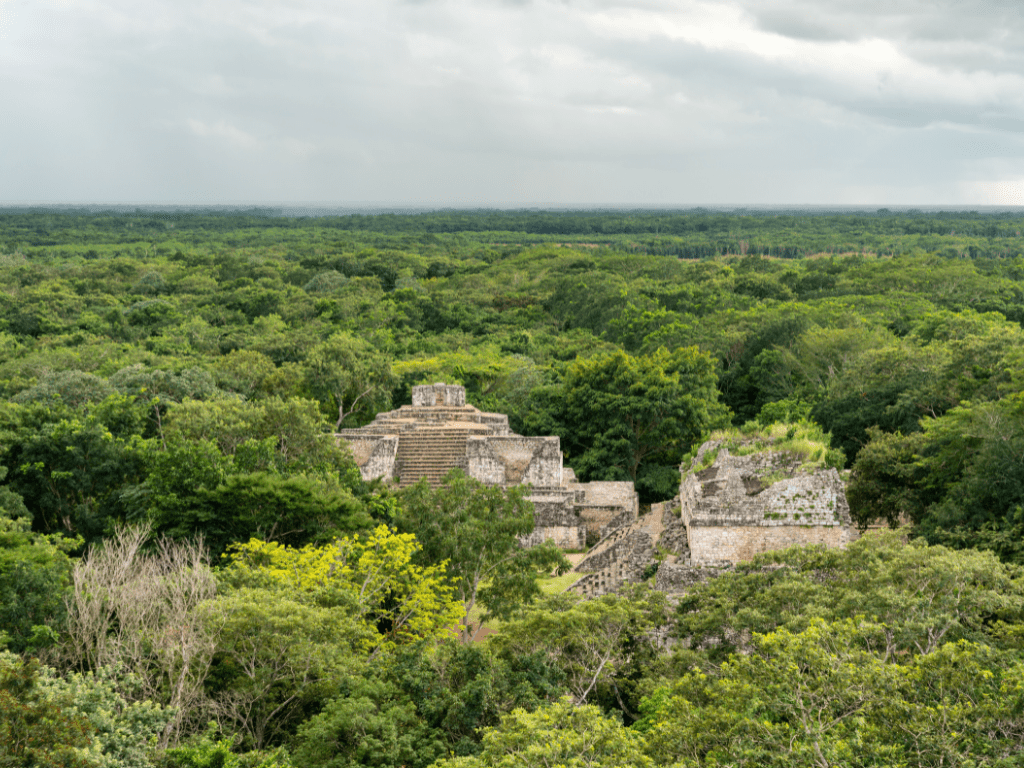Ek Balam Ruins: Uncovering the Enigmatic World of Ancient Mayans

In the heart of the Yucatan Peninsula, surrounded by lush forests and rolling hills, there lies a hidden gem: Ek Balam ruins. This ancient site is believed to have been an important political, economic, and cultural center for the Mayan civilization from 300 BC to 1100 AD. Today, it continues to captivate and inspire visitors with its intricate artwork, unique architecture, and rich history.
A Brief History of Ek Balam Ruins
The name ‘Ek Balam’ translates to ‘Black Jaguar’ in Yucatec Maya language. It was named after one of their kings who ruled over this region during the late Classic period (600-900 AD).
The ruins were first discovered in the early 1900s by archaeologist Teobert Maler but remained largely unexplored until recently due to its remote location and dense vegetation. It is believed that Ek Balam was a bustling city during its peak period.
The city covered an area of approximately 12 square kilometers (5 square miles) and was home to around 10-15 thousand people. It had complex systems for water management, agriculture, trade networks with other Mesoamerican cultures such as the Aztecs and Toltecs.
The Importance of Ek Balam Ruins in Mayan Civilization

While there are many remarkable ruins throughout Central America that attest to ancient civilizations’ sophistication and creativity, Ek Balam has long intrigued scholars about its special place within Maya society. The discovery of several significant murals on one building at Ek Balam has helped researchers piece together valuable information about the ancient city’s social organization as well as religious beliefs that formed a significant part of daily life. Furthermore, the site’s unique architectural features, including concentrically arranged plazas, massive stone gates, and elaborate stucco carvings, demonstrate the highly developed building techniques and aesthetics that defined the Mayan civilization’s identity.
In addition to its archaeological significance for historians and other researchers, Ek Balam also holds enduring cultural importance for contemporary Mayans living in the region. The site has become a source of pride as well as an important tourist destination that helps showcase their rich heritage.
The historical artifacts discovered at Ek Balam continue to reveal new insights into one of ancient history’s most fascinating cultures. This article will explore some of these findings in greater detail to provide a comprehensive insight into this remarkable ancient city and its people.
Location and Layout of Ek Balam Ruins
Geographical location of the ruins

The ancient Mayan city of Ek Balam is located in the state of Yucatan, Mexico. The ruins are situated approximately 30 kilometers northeast of the city of Valladolid, close to the northern edge of the Yucatan Peninsula. The site was strategically located in an area known for its fertile soil and cenotes, which were important sources of water for the Maya.
Overview of the layout of the ruins
The layout of Ek Balam is similar to that of other Mayan cities. It includes a central plaza surrounded by various structures such as pyramids, temples, palaces, and ball courts. The main pyramid at Ek Balam is called El Torre or “The Tower,” which stands over 100 feet tall.
Other notable buildings include the Oval Palace and Acropolis. One unique feature at Ek Balam is a long wall that encircles a large portion of the complex.
This wall measures over 1 kilometer in length and up to 4 meters high in some places. The purpose and significance of this wall are still not fully understood.
Significance of each structure in the complex
Each building within the complex at Ek Balam served a specific purpose for its inhabitants. For example, El Torre was likely used for ceremonial purposes or as an astronomical observatory due to its alignment with celestial bodies.
The Oval Palace was probably used by royalty or other high-ranking officials for administrative purposes. The Acropolis is another significant structure at Ek Balam that contains several buildings on top of a large platform.
These buildings likely served various functions such as residences or workshops. Overall, understanding the significance and function behind each structure within Ek Balam provides insight into Mayan society and culture during this time period.
Architecture and Design
Unique Architectural Features at Ek Balam

The architecture of the Ek Balam ruins is unique and distinctive among Mayan ruins. One of the most conspicuous features is the massive defensive walls that surround the central complex, which are up to 13 feet high and 26 feet thick.
The entrance to the walled city was through a narrow opening called a “chicanna,” which was designed to slow down enemy forces. Additionally, there are many elaborately decorated buildings with intricate stucco façades, such as the Acropolis, which was built in several stages and includes a number of ornate carvings.
Comparison with Other Mayan Ruins
Ek Balam’s architecture is different from other Mayan ruins in several ways. For example, unlike Tikal or Chichen Itza, there are no pyramids or ball courts at this site.
Instead, there are many low-lying buildings that are connected by sacbeob (white roads) that were used for ceremonial purposes. The lack of pyramids has led some experts to speculate that Ek Balam may have been more focused on agriculture than other Mayan cities.
Explanation of Design Principles Used in Construction
The design principles used in constructing Ek Balam were highly sophisticated and adaptable to different environments. For example, some structures were built on natural hillsides while others were constructed on raised platforms made from fill dirt. In addition, many buildings had multiple levels with internal staircases and vaulted ceilings made from overlapping stones called “corbeled arches.” These arches helped distribute weight evenly across the building’s foundation and helped prevent collapse during earthquakes or other natural disasters.
Overall, Ek Balam’s architecture reflects an impressive level of innovation and engineering prowess that was characteristic of Mayan civilization at its height. By studying the unique features and design principles of this site, we can gain a deeper understanding of how the Mayans built and used their cities.
Art and Decorations
Description of Artwork Found at Ek Balam
The artwork found at Ek Balam is a fascinating blend of various styles and techniques. One of the most prominent examples is a stone frieze depicting Chaac, the Mayan god of rain. The sculpture features intricate detailing of Chaac’s facial features, as well as his elaborate headdress and jewelry.
Another notable piece is a carved lintel that depicts a royal couple engaging in a ritual dance. The composition is dynamic and expressive, with the figures appearing to move in rhythm with the music.
In addition to these larger pieces, Ek Balam also boasts many smaller sculptures and carvings that are equally impressive. These range from simple effigies of animals to more complex scenes depicting mythological creatures or important events in Mayan history.
Interpretation and Meaning Behind Artwork
The artwork found at Ek Balam provides valuable insight into the beliefs, values, and cultural practices of the Mayan people who built this site. For example, many of the sculptures depict religious figures such as gods or priests engaged in ritual activities like sacrifice or prayer.
By studying these works closely, researchers can gain a better understanding of how Mayan religion functioned on both an individual and societal level. Similarly, some of the artwork at Ek Balam offers clues about how Mayan society was structured politically.
For instance, some friezes depict rulers engaged in various activities such as hunting or warfare. By analyzing these scenes alongside other historical evidence such as hieroglyphic texts or architectural features, scholars can piece together a more complete picture of how power was organized within Mayan civilization.
Comparison with Other Mayan Art Styles
While much of the artwork found at Ek Balam shares stylistic similarities with other Mayan ruins such as Chichen Itza or Tikal, there are also some notable differences. For example, the sculptures at Ek Balam tend to feature more elaborate detailing and a greater sense of individuality than those found at other sites. Additionally, the use of vibrant colors such as red, blue, and green is more prevalent at Ek Balam than in many other Mayan art styles.
Overall, the artwork found at Ek Balam is a testament to the creativity and skill of the Mayan people. Through careful study and analysis, researchers can gain a deeper understanding not only of Mayan culture but also of the ways in which art can shape and reflect society more broadly.
Daily Life at Ek Balam Ruins
Lifestyle and Culture During the Time Period
The Mayans of Ek Balam were an agricultural people, and their daily lives revolved around farming. They grew a variety of crops such as maize, beans, squash, and chili peppers. They also hunted wild game such as deer and turkey.
The people of Ek Balam were highly skilled in agriculture techniques for growing crops in the tropical climate of the region. Religion played a significant role in Mayan society at Ek Balam.
The ruins contain many structures dedicated to worship and ritual practices, such as temples, altars, and shrines. Mayan religion was polytheistic, with gods representing various aspects of nature or human life.
Explanation about How People Lived, Worked, Worshiped, etc.
Mayan homes were made of thatched roofs supported by wooden poles or stone walls. The houses had small windows to keep cool air inside during hot days; they also had no chimneys which meant that smoke from cooking fires filled the indoor air spaces.
The people of Ek Balam used a variety of tools for everyday life such as stone knives for cutting plants or wood for building homes and furniture which allowed them to build long-lasting structures even today. Women wove cotton into clothing while men created pottery using clay.
When it came to trade within the community or other nearby settlements – they exchanged goods like jade from Guatemala with other tribes living in different regions. – Understanding daily life at Ek Balam helps us gain insight into how this ancient civilization contributed to our modern world today through their agricultural practices, religious beliefs, home construction methods etc.
Conclusion
Preserving Ek Balam for Future Generations
Ek Balam is a unique and significant site that represents the Mayan civilization’s rich history and culture. It is essential to maintain and preserve this historical site for future generations to learn from and appreciate its value.
Preservation efforts have been ongoing with the construction of covers over some of the structures to protect them from weathering, erosion, and human intervention. The local government has also put in place strict regulations to ensure that visitors respect the site’s cultural significance.
Enhancing Visitors’ Experience at Ek Balam
To enhance visitors’ experience at Ek Balam, it is important to make preparations before visiting. Bring comfortable shoes, sunscreen, hats or umbrellas (for shade), insect repellent, water bottles, snacks (to fuel you through your visit), and a camera (to capture memories). Guides are available at the entrance who can provide a more in-depth understanding of the site’s history, architecture, art, religion, culture as well as interesting stories behind structures found at Ek Balam ruins.
Dress appropriately for hot weather conditions but also out of respect for this historical site; wearing clothes respecting cultural norms will help preserve its integrity. Moreover,
visitors should adhere to rules such as not touching any artifacts or climbing on any structures or walls since these actions may cause damage to delicate structures and artwork present throughout the area around Ek Balam ruins. Overall an unforgettable experience awaits those who visit Ek Balam ruins – a chance for people of all ages from all over the world to immerse themselves in this rich cultural hub while helping preserve it for future generations! Please keep in mind the Yucatan is scattered with Mayan ruins. Check out our list of the 8 most important Mayan ruins.


